
by plant4health | Mar 17, 2015 | grocery shopping, Nutrition, Plant-based, Recipes, Vegan, WFPB, Whole food
 It seems counter-intuitive that eating a healthy plant-based diet costs more then an unhealthy diet full of processed foods. Although cheaper in the short run, the cost savings of eating an unhealthy western American diet is countered as you age with the increase in health costs due to diabetes, heart disease, strokes, autoimmune diseases, and other chronic illnesses.
It seems counter-intuitive that eating a healthy plant-based diet costs more then an unhealthy diet full of processed foods. Although cheaper in the short run, the cost savings of eating an unhealthy western American diet is countered as you age with the increase in health costs due to diabetes, heart disease, strokes, autoimmune diseases, and other chronic illnesses.
But the immediate increase in costs of healthy organic foods can shock the pocketbook, making it a challenge for those living on a tight budget. When given the choice between a cheap, quick, heat and serve processed meal or a slightly more expensive, healthy, make it yourself meal that takes conscious effort, the cheap quick and easy usually wins out.
The good news is eating a plant-based vegan diet doesn’t have to break the bank. According to a study completed at the Harvard School of Public Health in 2013, it only costs about $1.50 more per person per day to eat healthy. It just takes a little strategy to shift your food choices and purchasing habits in order to keep the costs down. Here are some suggestions to help you save money: (more…)
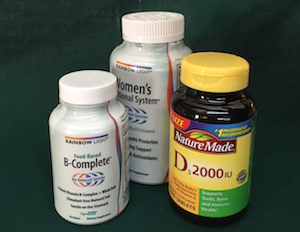
by plant4health | Mar 13, 2015 | Nutrition, Plant-based, Vegan, WFPB, Whole food, Whole food, plant-based
The vitamin supplement industry is a multibillion market – that’s billion, not million! Yet, according to Dr. T. Colin Campbell, “vitamin supplements are not a panacea for good health.” A whole food, plant-based (WFPB) diet plus adequate sunlight provides all the vitamins and minerals humans need with the exception of Vitamin B12 – which we’ll explore in this post. However, there are certainly cases where supplements are essential in the short term if you have a deficiency.
Nutrients in our food do not work in isolation but rather as a symphony. Taking a particular chemical nutrient out of context as a supplement doesn’t work for long-term health. And supplements for a single nutrient don’t always work the way the same nutrient present in natural foods do.
Beta Carotene & Vitamin E:
For example, there was a study in Finland where researchers followed cigarette smokers for 8 years. One group took supplements of alpha-tocopherol, a form of Vitamin E, another beta-carotene, another both supplements and another a placebo. The results were surprising. The group that took supplements had an increased lung cancer rate, while those on the placebo had a decreased lung cancer rate. Numerous other studies have found that supplements for Vitamins A & C, folic acid or antioxidants do not impact chronic diseases such as heart disease and cancer. (more…)
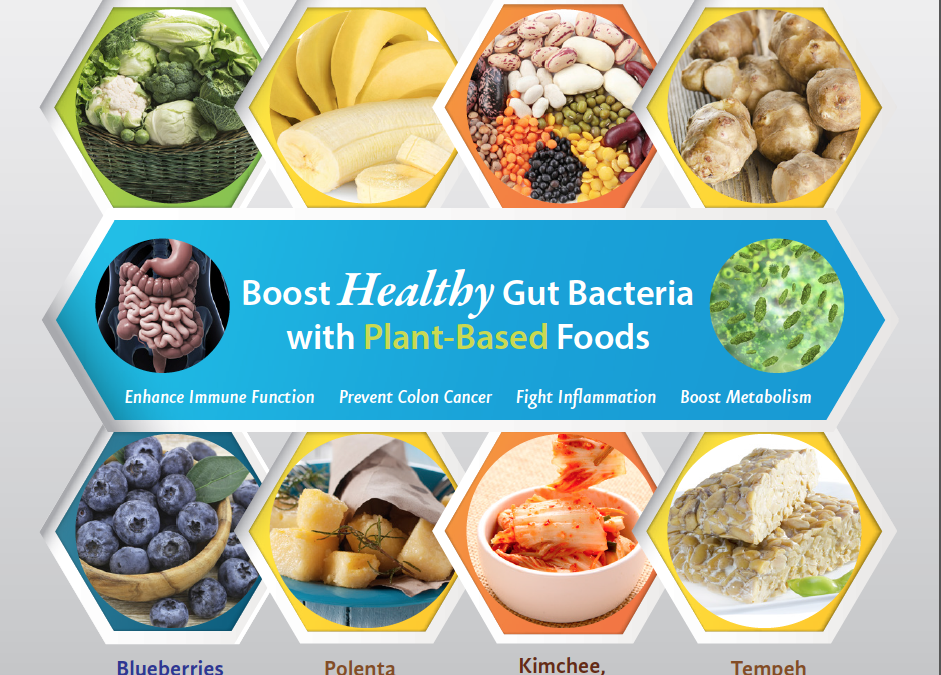
by plant4health | Mar 10, 2015 | Nutrition, Plant-based, Vegan, WFPB, Whole food, Whole food, plant-based
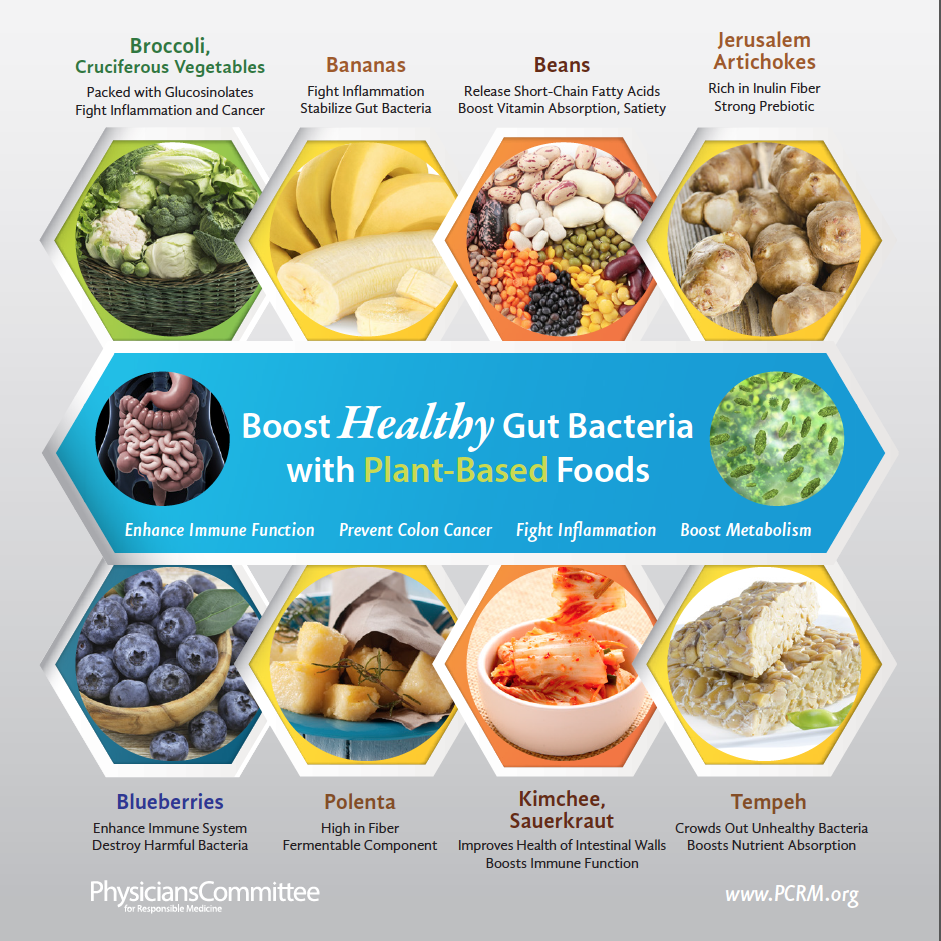
PCRM’s Infographic “Boost Healthy Gut Bacteria with Plant-Based Foods” www.pcrm.org
Your digestive system plays a crucial role in your healing process. This complex series of organs and glands break down the food you eat into nutrients that your body can absorb, using them to provide energy, heal and fight off disease. It then releases the toxic waste your body doesn’t need. As a result, it is essential for those with chronic illness and disease to pay close attention to their digestive health as a part of their healing process.
The foods you eat, your stress level and overall health all play a role in the effectiveness and health of your digestive system. This has been known since ancient times. The two oldest systems of medicine, traditional Chinese and Ayurveda, both focus on digestion as one of the key factors that influence heath, directing their healing efforts on the link between a person’s digestive system and their mental and physical well-being.
The biggest factors that contribute to poor digestion are:
- Chronic stress
- Diets low in fiber and high in processed foods, wheat, simple carbohydrates and sugars
- Chronic infections
- Antibiotics
- Non-steroidal anti-inflammatories (NSAIDs)
- Overuse of acid blockers (Prilosec, Nexium, etc)
- Low grade food allergies (dairy, eggs, corn)
Signs that your digestive system is out of balance:
- Gas
- Bloating
- Headache
- Burping
- Reflux
- Neck, shoulder, mid/lower back pain
- Fatigue following a meal
- Abdominal distention
- Constant hunger
- Bowel irregularity
Fortunately, there are several things you can do to bring your digestive system back into balance:
- Improve your gut flora: Your gut flora is made up of microorganisms that live in the digestive tracts and help your body digest and absorb nutrients and fight against intruders. Healthy flora is critical for whole body health. Your body cultivates new flora every 24 hours through the foods you eat. This healthy bacteria that lives in your intestinal tract thrives on colorful, plant-based foods such as cruciferous vegetables, bananas, beans, Jerusalem artichokes, blueberries, polenta, kimchee & sauerkraut and tempeh. PCRM has created a wonderful infographic that shows the properties of these foods that support healthy digestion titled Boost Healthy Gut Bacteria with Plant Based Foods. Learn more about how to restore your gut flora.
- Eat plenty of fiber – Fiber is important in maintaining regular bowel movements so toxins don’t build up and become reabsorbed into your body. Fiber is found in vegetables, fruits, grains and legumes. There are two kinds of fiber: Soluble fiber (i.e oatmeal, nuts, beans, apples and blueberries) slows down digestion as it breaks down into a gel in your intestines Insoluble fiber (i.e. seeds, grains, stringy parts or skins of plant matter) speeds up digestion as it passes through the body mostly intact . It is important to have both types of fiber in your diet.
- Drink plenty of water – water helps your body flush out toxins through your digestive system and softens stools. Fiber, like a sponge, absorbs water. A high fiber diet without enough fluid intake will cause constipation, resulting in the malabsorption of nutrients and the reabsorption of toxic waste that was delayed in being removed from the body.
- Manage your stress – when under stress, your body experiences the “flight or fight” response causing your central nervous system to shut down blood flow, this affects the contractions of your digestive muscles and decreases secretions needed for digestion. Stress can also result in inflammation of the gastrointestinal system. Some useful tools for distressing are: exercise, yoga, meditation, visualizations, deep breathing, spending time with friends or family, laughter, or communing with nature. Find what works for you. It can be as simple of learning to give yourself a “time out” when feeling overwhelmed to scheduling “me” time everyday to enjoy an activity you love. Learn more about stress and digestion.
- Exercise regularly – Aerobic exercise increases your breathing and heart rate, helping to stimulate the natural contraction of intestinal muscles. This doesn’t mean you should perform aerobic exercise after a large meal. Because digestion requires a large amount of blood flow, strenuous exercise right after a meal will stop digestion by redirecting the blood flow to support the increased need for physical activity. Instead, consider enjoying a slow leisurely walk which can actually stimulate digestion and relieve bloating.
- Take time to enjoy the your meal – When you eat too quickly your food is not broken down as well by chewing and the acid-neutralizing saliva that helps the food pass into your stomach is significantly diminished. This creates the perfect environment for heartburn and indigestion. Lingering over a meal with friends and family, chewing carefully and eating mindfully are important steps in creating healthy digestion.
- Sip on ginger tea. Ginger’s ability to relax the intestine muscles has made it a popular cure for stomach issues. However, it does so much more. According to the Chopra Addiction and Wellness Center, “a recent study in the European Journal of Gastroenterology and Hepatology found that ginger stimulates digestion by speeding up the movement of food from the stomach into the small intestine, and helps eliminates digestive discomfort after eating. In addition, ginger can stimulate saliva, bile, and gastric enzymes to aid in digestion of the food that has been ingested. “ They suggest drinking ginger tea regularly throughout the day by adding one teaspoon of grated or sliced fresh ginger root to a cup of hot water.
If you want to learn more, check out these articles:
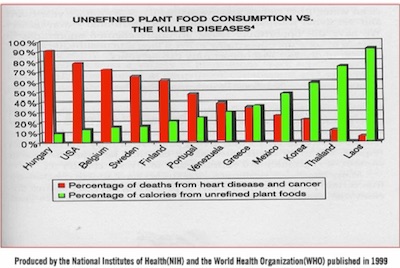
by plant4health | Mar 6, 2015 | Nutrition, Plant-based, Vegan, WFPB, Whole food, Whole food, plant-based
Doug Lisle, Ph.D. is a psychologist and co-author of The Pleasure Trap – Mastering the Hidden Force that Undermines Health and Happiness along with Alan Goldhamer. I had the “pleasure” of listening to a lecture by Dr. Lisle as part of the coursework I am taking to earn a certification in plant-based nutrition through Cornell’s online university, eCornell. Here are the key take-aways of Dr. Lisle’s lecture.
Most of us have been educated and quite frankly bombarded with messages about how to live a healthy lifestyle. When it comes to diet we know that eating more fruits and veggies is good and that we should avoid highly processed foods, sugar, the wrong kinds of fats, etc. Even though we know this information and may have a strong desire to follow a healthy diet, we find ourselves eating or drinking the wrong foods and beverages. Why is that?
(more…)
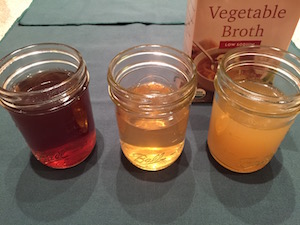
by plant4health | Feb 27, 2015 | Plant-based, Recipes, Vegan
Vegetable broth is handy to have on hand for making rice dishes, risotto, and soups. It’s convenient to buy at the store but be sure to look carefully at the ingredients. Some list carrots as the first ingredient and the broth can be orange in color and very sweet. Some manufacturers such as Whole Foods brand add a bit of sugar and oil which is best to avoid. Trader Joe’s Organic Hearty Vegetable Broth has carrots as the first ingredient but does not add sugar or oil. Try a few brands to see what you prefer.
Of course the best broth is what you make from scratch. It’s not difficult, just takes a bit of advanced planning. But it’s worth it. You can control how intense you want the flavors to be and design it for the dish you are making.
A time-saving (and money-saving) tip is to save clean vegetable trimmings in a gallon freezer bag as you are cooking other meals or making salads. You can use theses scraps that would otherwise get composted to make broth. Save onion and shallot peels and the ends of leeks and green onions; carrot and potato peels, ends of celery (and their leaves), chard stems and bell pepper. In a separate bag save mushroom ends. You’ll add the mushrooms if you want a darker, earthier flavor, especially if you are making a mushroom risotto. You can also add fennel which will give a licorice flavor. Avoid cruciferous veggies such as broccoli and cabbage as they will add a bitter taste. Red beets will turn it red.
You can make a broth using just the scraps plus herbs (see recipe below) or add additional vegetables which you can roast or sauté first if you want a more intense flavor. Here is a wonderful basic broth recipe from Anna Thomas, featured on Epicureous.
For a broth just from the scraps, use this recipe from thegardenofeating.org:
- Place 4-6 cups of scraps in a soup pot or dutch oven and add
- 1 bay leaf
- 3-5 cloves of garlic, peeled
- 4 branches of Italian parsley
- A sprig of thyme or 1 teaspoon dried thyme
- Cover with water, about an inch above the veggies, bring to a boil and simmer uncovered for about 45 minutes.
- Strain the broth through a colander lined with cheesecloth or a strainer.
If not using the broth right away, let it cool completely and freeze it in a freezer-proof container or ice cube trays, or store for up to five days in the refrigerator.
![The Amazing Healing Powers of Beets]()
by plant4health | Feb 24, 2015 | grocery shopping, Plant-based, Recipes, Whole food
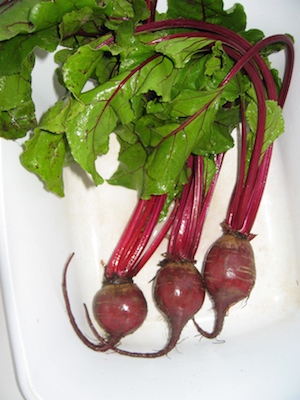 Beets are amazing! Packed full of vitamins and minerals, they are an important addition to any healing diet. Here’s just a few reasons why: (more…)
Beets are amazing! Packed full of vitamins and minerals, they are an important addition to any healing diet. Here’s just a few reasons why: (more…)

 It seems counter-intuitive that eating a healthy plant-based diet costs more then an unhealthy diet full of processed foods. Although cheaper in the short run, the cost savings of eating an unhealthy western American diet is countered as you age with the increase in health costs due to diabetes, heart disease, strokes, autoimmune diseases, and other chronic illnesses.
It seems counter-intuitive that eating a healthy plant-based diet costs more then an unhealthy diet full of processed foods. Although cheaper in the short run, the cost savings of eating an unhealthy western American diet is countered as you age with the increase in health costs due to diabetes, heart disease, strokes, autoimmune diseases, and other chronic illnesses.





